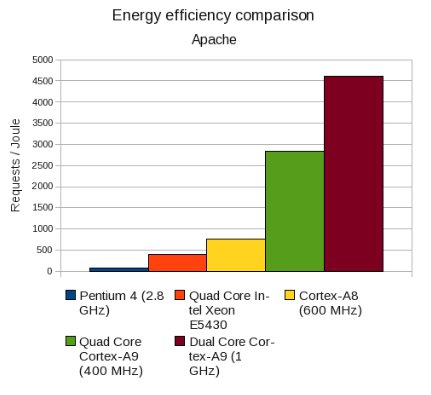Following “Pandaboard Cloud Cluster Running Google App Engine” post, there were some questions regarding the actual power efficiency of ARM servers vs Intel (Xeon) servers and some commenters questioned the performance of ARM chips. I’ve found a thesis evaluating how the energy efficiency of the ARMv7 architecture based processors Cortex-A9 and Cortex-A8 compares – in applications such as a SIP Proxy and a web server (Apache2) – to Intel Xeon processors. The focus of this thesis is to compare the energy efficiency between the two architectures rather than pure performance where the Xeon largely outperforms ARM processors, although a cluster of ARM servers could be used instead to reach the same processing power. Depending on the application, benchmarks indicate energy efficiency of 3-11 times greater for the ARM Cortex-A9 in comparison to the Intel Xeon. The full thesis (74 pages) is available below. Jean-Luc Aufranc (CNXSoft)Jean-Luc started CNX Software in […]
Xibo Digital Signage on ARM (Full Version)
Last month, I wrote a post showing how to run Xibo Open Source Digital Signage in a BeagleBoard/Overo emulator. That version could communicate with Xibo server, download the required files, display pictures and (maybe) play videos with the real hardware. However, it had serious limitation as Text, RSS and web pages could not be displayed. I’ve now fixed those issues and the full Xibo 1.3.1 can run on ARM platform. First, you need to follow the instructions given in Xibo Digital Signage on ARM (Beagleboard / Overo), although we’ll need to modify something with libavg compilation (see below). Then cross-compile berkelium for ARM using Linaro toolchain. Add libbrowser-node to libavg plugin directory and build libavg again. Also copy the Berkelium header files in to src/test/plugin (i.e. src/test/plugin/berkelium) or add the include file path to CFLAGS/CXXFLAGS.
|
1 2 3 4 5 |
bzr branch lp:~browsernode-team/+junk/berkelium-browsernode cp berkelium-browsernode/plugin/* ~/edev/beagleboard/libavg-1.6.0/src/test/plugin cd ~/edev/beagleboard/libavg-1.6.0 make make install |
Create libberkeliumwrapper.so:
|
1 2 3 4 |
cd ~/edev/beagleboard/libs/lib touch a.cpp arm-linux-gnueabi-g++ -c a.cpp -o a.o arm-linux-gnueabi-g++ a.o -shared -L/home/jaufranc/edev/beagleboard/berkelium -llibberkelium -o libberkeliumwrapper.so |
Copy the required files to the qemu image: sudo mount -o […]
Run 2 OS Simultaneously on ARM (OMAP4) with Codezero Embedded Hypervisor
B Labs, a company specializing in ARM Virtualization, was at ARM Techcon 2011 showcasing Codezero, their Embedded Hypervisor to run multiple Linux OS such as Android and Chrome OS on ARM processors. The main purpose of running 2 operating systems is to separate home and enterprise operating systems in mobile devices so that enterprise data is safe. Charbax (ARMDevices.net) interviewed Bahadir Baldan, founder of B Labs, and showed a demo running 2 Android instances and another running Android and Linux in pandaboard. The overhead is 10 to 15% according to B Labs, so the performance hit is minimal. They have already managed to run 4 OS on quad core processors with good performance. They are not able to run Windows operating systems (e.g. Windows Mobile 7.5/ Windows 8) yet, because Cortex A9 processors lack virtualization extensions. This will however be feasible with Cortex A15 processors as binary virtualization will be available. […]
ARM Unveils 64-Bit ARMv8 Architecture
ARM has just disclosed the technical of the ARMv8 architecture (to selected partners), featuring 64-bit instruction set support, extended virtual addressing, and backwards-compatible 32-bit support, so that software designed for ARMv7 (Cortex-A family) cores will run on the ARMv8 architecture. Here are the key points of the press release: The ARMv8 architecture consists of two main execution states, AArch64 and AArch32. The AArch64 execution state introduces a new instruction set, A64 for 64-bit processing. The AArch32 state supports the existing ARM instruction set. The key features of the current ARMv7 architecture, including TrustZone®, virtualization and NEON™ advanced SIMD, are maintained or extended in the ARMv8 architecture. … In support of the introduction of the ARMv8 architecture, ARM is working to ensure a robust design ecosystem to support the 64-bit instruction set. The ARM compiler and Fast Models with ARMv8 support have already been made available to key ecosystem partners. Initial […]
Texas Instruments OMAP 4 / OMAP 5 Update at ARM Techcon 2011
Katie Morgan interviews Brian Carlson, OMAP Product Line Manager – TI, at ARM Techcon 2011. They talk about current products using OMAP4 such as the Amazon Kindle Fire, Motorola Bionic, Motorola Razr and Toshiba AT200. Then they discuss about OMAP 5. Brian explains that OMAP 5 is an extension of OMAP 4 so that once you write software for OMAP 4 it will run on OMAP 5, so the transition is very easy. Products using OMAP 5 will start shipping end of 2012, beginning of 2013. They also talked about the new Cortex-A7 and big.LITTLE processing, but it seems there is no formal announcement from TI on the matter, right now. Finally, they showed two demos: an OMAP4 platform streaming 1080p video stream from Netflix and an augmented reality demo where you show a picture to the camera to start a video on the phone. Jean-Luc Aufranc (CNXSoft)Jean-Luc started CNX […]
Avnet and ARM Launch The Embedded Software Store
Avnet and ARM have jointly announced the launch of the Embedded Software Store during ARM Techcon 2011. This is a store where you can purchase or sell operating systems, software stacks, middleware and tools for embedded software development. The different software component are also classified in different markets namely automotive, communication, consumer, industrial, medical and military. There are already quite a few well known vendors such as Adeneo Embedded, Micrium, ST Microelectronics. Keil and more. Before a purchase you’ll be able to view product details and contact the vendor for details. Once the purchase is done, you an download the products immeditaly. Some products such as STM32F40x Standard Peripheral & DSP Library can actually be downloaded free of charge. So in the future, more silicon vendors may want to add their BSP, SDK and development tools free of charge to the site. Open source embedded software may also be available […]
Yocto Project Release 1.1 Announced
The Linux foundation announced Yocto Project Release 1.1 today. This release codenamed “Edison” and based on Poky 6.0 is the the second release of the project, one year after it was announced in October 2010 to provide developers with greater consistency in the software and tools they’re using across multiple architectures for embedded Linux development. The Yocto Project reached the following milestones during the last year: Alignment of OpenEmbedded technology and the inclusion of OpenEmbedded representation in the Yocto Project governance structure. The projects share a common core that consists of software build recipes and core Linux components that prevent fragmentation and reinforce the OpenEmbedded methodology as an open standard for embedded Linux build systems. Contribution of tools and technologies such as Cross-prelink, EGLIBC, Pseudo, Shoeleather Lab (for automated testing) and Swabber have been contributed from Intel, Mentor Graphics, MontaVista Software and Wind River. Commercial adoption with examples such as […]
ARM big.LITTLE Processing Demo
ARM uploaded a big.LITTLE demonstration by Nandan Nayampally, Director, Product Marketing. The demo runs the Android 2.3 (Gingerbread) with graphs showing CPU usage and when Cortex A7 / A15 is running. At the beginning Cortex A7 handles the background tasks, and when they start the Android Browser, Cortex A15 is used instead to render the page and once this is done, the system switches back to Cortex A7. Scrolling the webpage will increase CPU usage, but this will still be handled by Cortex A7. They did not have to do any modifications to Android, but they just added a big.LITTLE aware Power Management Driver which will be open sourced and integrated in future version of the linaro kernel. Jean-Luc Aufranc (CNXSoft)Jean-Luc started CNX Software in 2010 as a part-time endeavor, before quitting his job as a software engineering manager, and starting to write daily news, and reviews full time later […]








